Christine Valters Paintner's Blog, page 79
June 12, 2019
Enter to Win an Audiobook Version of The Soul's Slow Ripening
 From June 2019 – June 2020 we will be taking a sabbatical in celebration of our Jubilee year. Everyone who signs up for Level 2-4 of our Jubilee program before June 24th will be entered to win a prize – two people will be selected in a random drawing to receive the audiobook version of The Soul's Slow Ripening: 12 Celtic Practices for Seeking the Sacred. Winners will be contacted the week of June 25th.
From June 2019 – June 2020 we will be taking a sabbatical in celebration of our Jubilee year. Everyone who signs up for Level 2-4 of our Jubilee program before June 24th will be entered to win a prize – two people will be selected in a random drawing to receive the audiobook version of The Soul's Slow Ripening: 12 Celtic Practices for Seeking the Sacred. Winners will be contacted the week of June 25th.
June 11, 2019
Monk in the World Guest Post: Beth Adoette
I am delighted to share another beautiful submission to the Monk in the World guest post series from the community. Read on for Beth Adoette's reflection "Grace. Daily Grace."
I am not a fan of catchphrases. They make me cringe. “One Day at a Time” is one of those sayings that seemed to be written on every other card I received in the mail when I was going through a serious health issue years ago. “Just Breathe” is another one. Two words that can create in me more anxiety and hyperventilating than attempting to be still without them.
But I don’t dismiss these well-intended sayings. I understand there is wisdom in there somewhere. The challenge is transforming simple words in my mind into deep understanding in my spirit. For this, I need a translator. And for me, the translator is Nature. That never-ending, extravagant collection of wisdom and grace wrapped in, and often disguised as, beauty.
To grasp “One Day at a Time” during my health crisis, I used to imagine I was in the woods where I grew up, able to see only one part of the path from my feet to the big, moss covered rock that blocks the view of the rest of the path until you reach and circle around it. “Yes, I can do that,” I would say to myself. “I can travel that part of the path today.” For “Just Breathe,” I remind myself that I am connected to every living thing on earth through the collective breath. I close my eyes and imagine I am slowly breathing in and out with chickadees and ladybugs. I immediately calm down.
Lately, I have been wrestling with another phrase. “Living in the Moment.” A wonderful aspiration, but truth be told it terrifies me. It asks me to look squarely at what is happening right now. No more avoiding the present by looking toward the goal of that big, moss covered rock ahead. I must stand still. I must look at my feet. I am afraid. I need the powerful, yet gentle voice of nature to help me. So that is where I go.
Here in southeastern New England, there is a road that runs between the river and the ocean. At sea level, it is a low vulnerable place. The wind is often fierce. The fickle temperature changes cause the road to buckle. And because of its exposure to the elements, it is often in disrepair. At high tide, the water rises over the pavement, the ground shifts, and the edges begin to crack. It is the place where man-made and natural interact. A perfect place for contemplation. I go there often to walk along the edges.
Like the road, I am vulnerable. I am getting older. I have lived through stuff. There are cracks in my road. There are scars. There are things that may not change. There are questions that may never be answered. I am afraid to be still. It feels like the pause between breaths without chickadees and ladybugs . . . only longer. How can I be brave enough to look at the cracks? How can I be strong enough to face reality? The answer is in the tides.
What I have not yet mentioned about the little river road are the gifts that come in with the tide. As water is slowly pulled up over the road by the circling moon, it carries little pieces of reeds and grass. When the water recedes, beautiful chaos is left behind to settle in the cracks. Daily, the water washes over. Daily, it brings new gifts. Daily, it creates new designs. I realize I don’t walk along the road to see the cracks, I go to see what has settled in them and witness the cracks and grasses working together to create something beautiful.
But even more comforting than the beauty I find along the edges is the faithfulness of the tides.
You can do nothing to stop them. No matter what you do, or have done, the fact is the tide comes in everyday, brining new gifts to soften the unplanned gaps in the road. It is not something you have to ask for. It is already done. All you need to do is look. Eons ago when the Creator set the moon in place, the tides began to rise and fall and have not stopped since. Light and dark. High and low. Power and gentleness. Opposites. Balance. It is Grace. Daily Grace!
Here at the edge of the road where I sometimes feel vulnerable and alone, where I go to find feel God’s presence, the tides are my assurance. A tiny glimpse into the Great Mystery that holds the immense universe together in perfect balance, and a voice that also speaks to me, little me, helping me be brave enough to look at my feet on the pavement. As the moon circles and the tide rises, I am reassured that gifts in different forms will come to soften the cracks in my road.
To “Live in the Moment” is to be still, present, and witness the beauty of reality and grace working together to create beauty under my feet. That is Grace. Daily Grace.
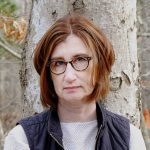 Born in the Appalachian Mountains, Beth Adoette grew up with beech trees, hemlock, mountain streams, and chickadees in her hand.
Born in the Appalachian Mountains, Beth Adoette grew up with beech trees, hemlock, mountain streams, and chickadees in her hand.
A long time resident of southeastern New England, she now concentrates on writing, illustrating, and photographing what she calls the “Contemplative Sacred Circles” she co-creates with nature.
Beth holds a BFA in Fine Arts and certification in Eco-Art Therapy. She recently published her first illustrated book, A Year of Sacred Circles, Hearing Nature's Voice in Silent Conversations. Visit her online at BethAdoette.com
June 8, 2019
The Spirit of Jubilee: A Love Note from Your Online Abbess
 Fling wide the gates,
Fling wide the gates,
open the ancient doors,
and the Holy One will come in!
—Psalm 24
Dearest monks, artists, and pilgrims,
In preparation for our Jubilee year of sabbatical I have been reading Maria Harris’ book Jubilee Time: Celebrating Women, Spirit, and the Advent of Age. She begins with the image of Crossing the Threshold which has been a potent one for me for many years, perhaps because I have felt my life to be a whole series of thresholds summoning me to new mysteries and adventures. She draws from the biblical text which John explored for you in last week’s love note. Jubilee is a time of both letting go and deepening into freedom.
Approaching my 50thyear I feel grateful every morning for this life I lead, with a wonderful husband, in a beautiful landscape, with many collaborators, and meaningful work with open-hearted participants. I feel as though the year ahead offers me a chance to savor even more, to rest into spaciousness and discover what awaits me there. Maria Harris describes the 50thyear as an orientation time. She mentions the ancient practice of orienting churches along the east-west axis so that the altar faces the dawn and the time of new beginning. This is a time to begin again. She also includes the quote from Psalm 24 above in her text and I read in it an invitation to make space for the sacred to enter my life in new ways.
I enjoy getting older and the wisdom that life experience brings with it. I cherish the keen awareness I have of my limited days on earth and how I want to inhabit this time. The season ahead is an opportunity to realign myself with what makes my heart sing the loudest and to see where perhaps my energy no longer needs to be directed.
Maria Harris writes: “Saying no is a significant Jubilee moment. It symbolizes turning away from external demands on our time and acknowledging we have a right, even a duty, not to say yes to every request that comes our way.” I have long been a fan of the word no, of setting clear boundaries so my energy can thrive. But sometimes a pause is necessary to reevaluate, to see where there have been perhaps too many yeses.
Many of you might be familiar with the concept of peregrinatio which I have written about many times. This Celtic form of pilgrimage involves stepping into a boat without rudder or oar, and letting the currents of divine love on the wind and water carry them to the place of their resurrection. This year ahead feels in many ways like a practice of setting aside my own agenda as much as possible. I have been asked many times by folks what we’ll be doing during our sabbatical. And while there are some practical answers to that question – a book I am committed to write on Sacred Time, a couple of pilgrimage experiences that have called to our hearts – mostly I am hoping for time to just listen deeply to where the currents of my life are carrying me now. My planning mind wants to figure out what this time ahead will mean. My intuitive heart knows better to rest into the mystery of things and allow for holy surprises to emerge.
What plans might you release to let yourself be carried to the shores of your heart’s unfolding?
We would be really honored and delighted if you were able to support this time ahead in some way, especially to continue our website and email newsletters which cost a lot to maintain. Anything at all you can contribute is most welcome as well as your prayers and blessings!
Everyone who signs up for Level 2-4 of our Jubilee program before June 24th will be entered to win a prize – two people will be selected in a random drawing to receive the audiobook version of The Soul's Slow Ripening: 12 Celtic Practices for Seeking the Sacred. Winners will be contacted the week of June 25th.
With great and growing love,
Christine
Christine Valters Paintner, PhD, REACE
Photo © Christine Valters Paintner
June 4, 2019
Wisdom Council: Guest Post from Michael Moore
I am delighted to share another beautiful submission from one our newest Wisdom Council members. Read on for Michael Moore's "Reflections on the Contemplative Life."
What is Contemplative Life? When I first became aware of the term, I associated it with Monks and Nuns in Monasteries and Convents who lived in relative isolation from the outside world. To be honest, I didn’t really see how it could apply to me during my 21 years as a US Air Force Chaplain. That understanding began to turn during the last three years I was in the Air Force. I found myself going through a divorce and a crisis of faith. I was also becoming increasingly disillusioned with the Chaplain Corps and was trying to discern what was next. As I faced retirement and the next step (going back into the church as a pastor) I found myself spending time on the Gulf listening to the waves crashing ashore. During that time, living alone, I had plenty of time in the silence. However, at that point in my life, silence was threatening because in that silence I had to face myself and all my fears and failures. Over time and with healing, silence became less of a threat and more of a comfort to me. Photography slowly became a method of contemplation in this journey of life.
I received my first camera when I was twelve years old. It was a hand-me-down from my Mom. Over the years I took hundreds of pictures, but it was only to document the “where I have been and what we have seen” moments. As I faced the changes and challenges before me, I began to see photography as something more than just compiling pictures. This was an incredibly slow process for me as I allowed my perspective to change. It wasn’t until I took a course on Thomas Merton and sat with some of his pictures in the Chapel during worship that I began to see how the Contemplative life could be expressed in a way that was familiar to me. Thanks to Thomas Merton and our own dear Abbess Christine, photography is becoming a lens for receiving what God offers and an opportunity to simply Be Still.
Life rushes on for so many people today. My wife Denise and I love to go hiking in our backyard, the Rocky Mountain National Park in Estes Park, Colorado. On the trails and roadways, we see so many people rushing by us to check some item off their list before scurrying off frantically to capture their next moment. Last Fall, we were intentionally hiking off the main trail and simply breathing in the atmosphere and stillness of the moment. As we walked, we were both taking pictures and simply receiving what God had for us in those moments. Out of the corner of my eye, I spotted antlers in the brush. We were in the presence of a mature Bull Moose who was taking a siesta underneath a tree. From a safe distance we spent the next 45 minutes communing with our new friend. He knew we were there as we acknowledged him, but the calm of the moment invited the three of us to simply Be Still. As he rose to leave, he looked at us and stood still so we could receive some wonderful images with our cameras. If we had been rushing through the park as so many of our visitors do, we would have missed out on this sacred moment.
The idea of the contemplative life has been transformed from my initial thoughts years ago that I related at the beginning of this blog. That is part of the beauty of the invitation offered by Abbess Christine and the Abbey of the Arts community. Being invited to become Monks in the World is an invitation to slow down amid the frantic hurry and scurry of life today. It is an invitation to simply Be Still in the moment and breathe in what the Spirit is offering us. It is an opportunity to see and experience life in a different way.
After two funerals on a recent Friday and Saturday and worship and a meeting after worship, even though I was exhausted, Denise and I went into the Park with our cameras. Our godson and his girlfriend were visiting and so we wanted to help them enjoy Rocky. As cars whizzed by us, we drove slowly and intentionally until we received the gift of a moment with another Bull Elk who was busy resting and re-growing his antlers. We received, in that moment, a treasured gift. This is a lifelong learning process for me as it is for each one of us. In the midst of more Hospice visits and meetings at church, I need to remind myself again and again to slow down for a moment. In that moment, to take a sacred pause and simply Be Still. That, dear reader, is the gift of the contemplative living!
 Michael Moore is a retired USAF Chaplain and pastor in the Presbyterian Church (USA) who currently lives in Estes Park, Colorado with his wife and partner in life and ministry, Denise. His undergraduate degree is in Business Administration (University of Wisconsin at Eau Claire) and he earned his Master of Divinity degree from United Theological Seminary of the Twin Cities (Saint Paul, MN). He served two small yoked Presbyterian Churches in rural Fergus Falls, MN for three years before going on Active Duty with the USAF for 21 years. Following his retirement, he served a church in Florida for four years before going to his current call in Estes Park in 2015. He has a Certificate in Christian Spiritual Formation from Columbia Presbyterian Theological Seminary in Decatur, GA. A writer and photographer, you can find him blogging at ScotsIrishPadre.blog or at GodSpaceLight.com as a member of that community.
Michael Moore is a retired USAF Chaplain and pastor in the Presbyterian Church (USA) who currently lives in Estes Park, Colorado with his wife and partner in life and ministry, Denise. His undergraduate degree is in Business Administration (University of Wisconsin at Eau Claire) and he earned his Master of Divinity degree from United Theological Seminary of the Twin Cities (Saint Paul, MN). He served two small yoked Presbyterian Churches in rural Fergus Falls, MN for three years before going on Active Duty with the USAF for 21 years. Following his retirement, he served a church in Florida for four years before going to his current call in Estes Park in 2015. He has a Certificate in Christian Spiritual Formation from Columbia Presbyterian Theological Seminary in Decatur, GA. A writer and photographer, you can find him blogging at ScotsIrishPadre.blog or at GodSpaceLight.com as a member of that community.
June 2, 2019
Sacred Rhythms of Sky, Sun, Sea and Stone: Participant Poems ~ Kathy Marsh
In April, 18 creative souls gathered with us for our retreat on Inismor – Sacred Rhythms of Sky, Sun, Sea and Stone. We had a wonderful group with participants from all over the U.S., Canada, U.K., and Australia. I am delighted to share some of their poems. Pour a cup of tea, imagine yourself on a windswept limestone island in the Atlantic, and savor for a while.
From Kathy Marsh
Morning Blessing
Lilting through the air,
The full-hearted song of bird
Weaves into the air,
Braiding into a joy
That touches the landscape and
Tapestries into
The crevassed walls;
The muted, mingled shades of earth;
The bright, unexpected blue, of flower.
The Spirit dances through the long grass,
Pausing to breathe into the stillness,
Then wooshes up in praiseful delight
Which sculptures the clouds
Where the birds weave, before
They alight to sing their paean of praise.
Do you like the smell of garlic?
The path winds into the sacred grove
Of dappled light, where sunlit shadows play.
The sun warmed air caresses and coaxes the
White starred accolytes
To release their scent in benediction,
Perfuming the air
Where bees lazily drone
And flies swarm the air.
Fallen tree sculptured by tactile moss,
And succoured life gently creeps
Into a lush carpet of shaded green,
Where the wild garlic bloom
Their star brightness across a green sky
Of verdant bloom.
Introspection
Like mirrored glass
The sheen of unruffled water lies,
Deep.
What stirrings of life
With their stories untold,
Deep
Beneath the pure glisten
Of reflective beauty
Lie?
What secrets and shapes
Coalescing into form?
Imagine,
The reflective surface
Turned to mirror down
Deep.
What glimpsed stirrings
Will I see?
Freefall
Eyes focused, instinct honed,
The raptor dives,
Arrow-piercing through the air
As it screams the wind down.
Talons locked on prized prey,
Then heaved away.
What if? …. …..
Talons unlock,
Prey unprized, falls away,
Weighting through the air.
The raptor now airborne ,
Wings lightened, flies free.
Reflections on Inismor
The journey unravels,
Revealing mystery of landscape,
Where feet have trod, have trod,
Traversing the flint-stone pathways,
Past the crevassed walls
That stone by stone were toiled,
And heaved from the bare-boned earth.
Now lichened and mossed.
Man’s imprint but a passing shadow
That fades into the flint-faced soil.
The walls of houses
Blank-eyed. The
Glint and spark of life, melded into
The dancing drifts of wind and air.
Hermit cells and altars
Lying open, in homage
To the immensity of sky,
Where the clouds gather
And the salt breezes blow.
And yet, and yet,
As I sit on the alcove seat
Of ruined church,
Hearing bird chatter interweaving
With gull’s strident call;
Sea’s distant murmuring
And churn of wave on rock.
I feel the pulse of life
As the storied lives
Of monk and hermit
Babble in my mind.
The stones beneath my feet,
Once moved by the tread of those,
Who trod, who trod.
My journey spools into a gathering yarn;
An ancient weaved pattern told by
Work-hardened hands,
That weave still the island’s stories;
Lived into shape and fireside gathered.
I hear now the island’s voice,
Which lives and dances into song.
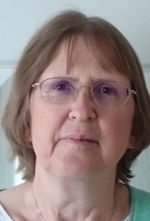
For Kathy Marsh involvement in family and community life are important. Kathy runs a local contemplative group and is also a Spiritual Director. She has written a booklet, Writing Prayer Poetry: How to Deepen Your Prayer Life (published by Grove Books Ltd), as an encouragement to others who would like to creatively journey into prayer, and has just started co-running workshops based on 'Writing into Prayer'.
June 1, 2019
A Celebration of Poetry ~ A Love Note from Your Online Abbess
 Dearest monks, artists, and pilgrims,
Dearest monks, artists, and pilgrims,
I hope you have enjoyed the series of poetry videos we have produced in collaboration with Morgan Creative. One of our great joys here at the Abbey is bringing artists together whether through these videos, the albums we are creating, or the icon series we commissioned. When time and resources allow we hope to continue these video offerings. For now, I thought I’d share links to all eight of the poems in case you have missed any of them over the last few months:
St. Gobnait and the Place of Her Resurrection
Dreaming of Stones and poetry book trailer
Your can order your own copy of Dreaming of Stones.
One of the things that calls to me most strongly for our Jubilee year ahead is to have the time and space to write more poems. I am close to enough for a second collection on the theme of the wisdom of wild grace. These include a series of poems about the stories of saints and animals which I have been meditating on. You can read one of the poems in this series, St Melangell and the Hare, at Bearings online.
Poems for me always begin with the seeds of images in my journal. My favorite time to write is first thing in the morning, after I have fed Sourney and taken her out, I love to climb back in bed with her and a cup of tea or coffee. I often sit in silence for a while and then read a poem or two from another writer and practice a modified version of lectio divina with these texts, listening for a word or phrase that shimmers for me. I let that unfold in my imagination and the images that arise often form the seed of a poem I will write. It is very much a contemplative practice that for me requires a commitment to time and space. Writing poetry is very much an act of cultivating wonder for myself and hopefully for my reader as well. It is about seeing the world beneath the surface of things and offering it back through language.
How does poetry (whether reading or writing) inspire your own life and spiritual practice?
I have a few bonus things for you to read and listen to this week – two articles I have had published recently with U.S. Catholic magazine and a podcast at Spark My Muse:
8 Faces of Mary to Call On in Prayer
12 Celtic Spiritual Practice that Celebrate God in Our World
Celtic Practices and Poetry (Podcast)
With great and growing love,
Christine
Christine Valters Paintner, PhD, REACE
Photo © Christine Valters Paintner
May 28, 2019
Monk in the World Guest Post: D.G. Hollums
I am delighted to share another beautiful submission to the Monk in the World guest post series from the community. Read on for D.G. Hollums' reflection on carving space for the nourishing Sacred Heart.
I love. I love passionately and deeply as a self proclaimed contemplative extrovert and neo-friar. But I’ve also found that loving deeply and passionately also means hurting deeply and passionately sometimes. Life has taken me on some very desolate and dark times. Times that have rocked me to my core and have tried to rob me of that passionate love and joy, both of which are so distinctive to who I am. Those who do not know my depths might think I am spontaneous or unpredictable, but in fact, I’ve discovered during these dark trying times that I’ve found peace and solace in rhythms. For in these rhythms my soul has been renewed and has found peace.
Holy rhythms.
Morning prayer. Singing vespers with my wife and young daughter before bedtime or praying my decade rosary on my commute each day. These rhythms have ministered to my soul and provided a constant when little else has. For many years now, the contemplative practice of Visio Divina (Divine Seeing) through contemplative photography has met a deep place in my soul. This was especially true when I lived in Albuquerque, New Mexico. Anytime I needed to spend a deep intimate time with our favorite loving Trinity, I would go take my camera and prayerfully enter into the desert or mountains and listen with the eyes of my heart to the world around me (thanks to our online Abbess’s book, “Eye’s of the Heart”).
Each stage in my life has seemed to be another uphill challenge that has managed to find new ways to drain me physically, mentally, emotionally, and spiritually. Any contemplative dancing monk should be the first to tell you that no matter how strong or passionate your desire is to live a life ‘above the fray’, life will always attempt to get in the way. Sadly, in my case, ‘life’ was represented by people who have hurt me to the core so many times I stopped being able to keep count. And the deeper sadness for me, has been that many of these people have been ‘in the church’…the very place and people who should never be the bearers of that kind of pain. That deep hurt and disappointment has taken my soul on several trips down the path of depression rather than the path of peace.
My family and I moved to Austin, TX to be able to circle around family facing their own physical ‘mountains’. It was a wake up call to my heart as those favorite places of the desert and mountains were replaced by the Texas Hill Country which, of course, is beautiful in it’s own right. But, my weary and dry soul was heartsick for the familiar holy places in the desert and mountain steams, where my heart seemed to still reside.
I felt lost and no amount of life rhythmic prayers was able to heal as I was desperately needing and craving. I was still searching for the way to find my place in the larger reign of God. My contemplative photography was not the renewing spiritual practice that it had once been for me and I was simply depending on the rhythms of my life to slowly bring me back to the path of peace as they had done for me in the past.
One day, while thinking about a gift idea for my wife, God brought to mind some of my very first years in ministry in Santa Fe, New Mexico. A master craftsman from the church I was appointed taught me some very basic and beautiful wood carving techniques that originated from the small town of Cordova, NM which is very close to the famous Sanctuario de Chimayo and it’s healing sand.
I decided upon a carving of a sacred heart for my first carving and gift. I realized that as I was carving, I found myself praying. With each small chip of wood falling off, there was a familiar rhythm in my carving and praying. As I slowly carved away the wood with my hand tools, the sacred heart slowly came into view. I also realized that when my carpal tunnel condition in my hands would cause them to go numb, it was God reminding me to pause…pray…and then begin again. As the wood began to take form, I was deeply touching the heart of Christ and carving away the wood that was keeping this heart from being viewed by the world.
After a few weeks of my new found love of contemplative carving, I was divinely inspired and realized it was the touch of the sacred heart of Christ in my hands and fingers that was slowly becoming a new spiritual practice for me. All those years of Visio Divina (Divine Seeing) was being translated into Contingo Divina (Divine Touch). And again, I was renewed, remolded, and refreshed with a new way of allowing God to enter into the ‘life’ and breathe his peace into my dryness.
I invite you to try holding things that are precious to you in a way that invites Christ to hold you in those hands. Remember that you are caressed and held tenderly in the heart of Christ when you are doing the dishes, crocheting blankets for others, and working in the garden. Go on a hike and pick up rock, flower, or blade of grass and allow God to speak to you in your touch… reminding you of God’s presence and care of you. Go and experience Contingo Divina in your own lives and the power of touch. Allow the very hands of God to hold you…mold you….and carve away the pinnings of this world that are keeping his divine image to be shown through you for the sake of the world.
[image error]


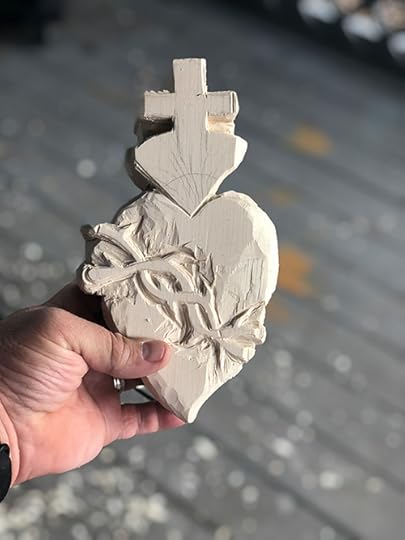


D.G. Hollums, is clergy in The United Methodist Church, born and raised in north west Texas and currently lives in Austin, TX. He is a geek, foodie, contemplative photographer, contemplative carver, daddy, husband, self-described "extroverted contemplative”, and considers every person he meets to be someone he can’t wait to get to know. He has been an associate pastor, lead pastor, church planter, director of online communications for the global United Methodist church, as well as worked for Tesla Inc. and Apple Inc.
D.G. is currently developing a new non-profit called The Order of the Trinity that would be a local and online community who promote a simple rule of life based around our 5 senses for a neo-friar-like people who love out their lives through art, creativity, and rhythms to make a difference in thier communities. If you are interested in supporting, helping or joining scroll to the bottom of the website and let us know, OrderOfTheTrinity.com

May 26, 2019
Sacred Rhythms of Sky, Sun, Sea and Stone: Participant Poems ~ Cyndera Quackenbush
In April, 18 creative souls gathered with us for our retreat on Inismor – Sacred Rhythms of Sky, Sun, Sea and Stone. We had a wonderful group with participants from all over the U.S., Canada, U.K., and Australia. I am delighted to share some of their poems. Pour a cup of tea, imagine yourself on a windswept limestone island in the Atlantic, and savor for a while.
From Cyndera Quackenbush
Wind
You came in Spring
What seed survived your incessant stirrings?
Plenty -
Yet you swept away all falsehood
A wind-whipped cleansing
Of all not Rooted
Branches, no longer reaching,
Betray their trunks
Totaling city cars with their wayward weight
Meanwhile you sing with insistent whistling
Through the Open Gate
Invisible, you are known outside
Heard Inside
The effects are visible
Especially in my hair
Like the soul, you cannot be seen
While we witness your presence everywhere

Fire (11 Illuminated Forms)
Inspired by Mark S. Burrows poem “Nine Forms of Light”
Light between Leaves,
Shimmering with Breeze
Light within Bird Wings
And in the Song that She Sings
Light in the Rainbow Grass Dew
Light in the Sky’s Eternal Blue
Light on the Rooftop
Lights in the Car Lot
Light on the Surface of Stone
Light in the Ringing Telephone
Light is in this Place,
Eyes Closed,
The Sun upon my Face
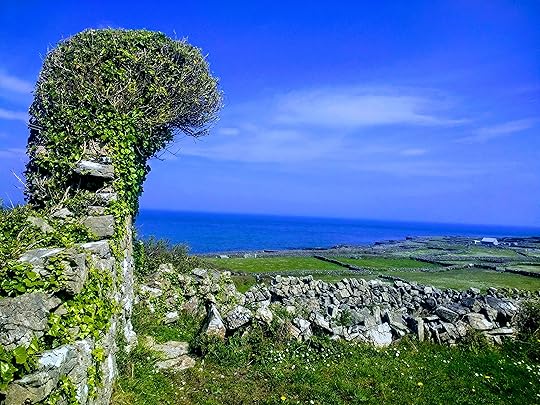
Water
In Praise of Laundry
The washing machine is a Womb
I could sleep to its sounds of churning
Vibrations of cycle changes
There are secret crevices
Where the fairy liquids go
And then
The waters flow-
A musical medley of clothes
Through a sea portal window
Out come the lavender scented parcels
They look like wet, wilted infants
Ready for the wear of life
I smell each one,
hold it close
And place it lovingly in the dryer
These Clothes,
Creations of daily identity
Will meet here again

Stones
St.Ones
At Midnight
The Moonlight
Spills through stone slits
Onto altar slabs
In illuminated dark,
I make out Heart
My fingers finding
the silk of stone
It used to be,
These entities could be a He or She -
This stone says She to me
Lips open to sky
She sings a soft stone song
How She,
A stone chosen, begins again
While doing nothing at all
The Big Dipper,
Found in this framed night filled with stars,
Reminds these roofless walls
Of the Possible, Possible
Promise
Of surrendering
To the Moon and Structures of God

Cyndera Quackenbush, MA, is a storyteller, educator and Reflection Card Reader in the San Francisco Bay Area. She is the creator of the Story Through Stone Reflection Card Deck, that features naturally occurring billion year-old imagery from rocks found in her native Mojave Desert. With the development of the Story Through Stone Reflection Card Reading Method, she assists individuals in uncovering their deeply known truths and insights with imagination and intuition. Find out more at StoryThroughStone.org
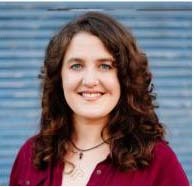
May 25, 2019
Jubilee Time (John’s reflection) ~ A Love Note from Your Online Abbess
 Dearest monks, artists, and pilgrims,
Dearest monks, artists, and pilgrims,
In honor of our upcoming sabbatical year, this week we hear from John Valters Paintner about the scriptural roots of Sabbath and Jubilee:
The biblical Jubilee is a big, if rarely discussed topic. So, we’re going to back up a bit and get a good running start at it from a point that is far more familiar with all of us.
One of the Ten Commandments is to “keep holy the Sabbath” (Exodus 20:8-11 & Deuteronomy 5:12-15). There is controversy, or at least vigorous debate, over the most basic of details. Catholics and Protestants don’t agree as to which number of the Decalogue it is. There is also the debate over which day of the week it should be practiced.
But at its core, the Sabbath is meant to be a day of freedom. It is freedom both from and for something. It is freedom from work, the labour of our earthly existence. And it is freedom for time to focus on our spiritual existence. It is not, as Pharaoh accused Moses and the Israelites, a day to be lazy and do nothing. It is a day to reconnect with the spiritual side of life.
The trouble comes in trying to figure out the correct balance. Despite our spiritual natures, we are still physical beings and there are certain tasks that still need to be performed. And so the debate rages on throughout the centuries on denominational and personal levels as to what should or shouldn’t be prohibited on the holy day.
Even Jesus ran afoul of proper Sabbath observance.
That gives me comfort, as it is a Commandment I’ve always wrestled with as an adult. When I worked in parish ministry, Sabbath was a very busy day . . . even if it was religious by nature. And then when I was a religion teacher, the weekend was my downtime and the last thing I wanted to focus on what work . . . again, even if it was religious by nature. At first, I was too busy with spiritual matters to rest. And then I was too busy resting to go about anything of spiritual matter. My Sabbath work/reflect ratio has never been what I’d consider correct, at least for me.
My personal dissatisfaction around this issue hasn’t gotten much better now. As a self-employed business owner, I find myself quoting a certain fictional Dowager Countess (if for very different reasons), “What is a . . . weekend?”
So yes, keeping holy the Sabbath isn’t easy. But before we can discuss the once (maybe twice) in a lifetime Jubilee year, we need to come to terms with the weekly Sabbath. Don’t panic; you don’t need to have perfect Sabbath observance to “graduate” onto the next level. Like all of life and spiritual practice, we’re all a work-in-progress.
We’re not big on hard and fast rules at the Abbey of the Arts; we’re very intentionally not dogmatic in that way. We’re much more in favour of offering guidelines to help you create a spiritual rhythm that is right for you. (Not that we’re preaching moral relativisms. We trust you to make the correct decisions for yourself, as we gently push your boundaries.)
So with that in mind, let’s start simple. Just pick a day of the week. Any day will do. Fewer and fewer of us are working 9-to-5, Monday-to-Friday schedules and so the weekend may not be ideal for you to take a day of holy rest. There’s no need to set yourself up for failure before you begin. Next, maybe it’s not a full day to start. Maybe you divide up the day into half or even quarter days throughout the week. Start small and get some momentum going.
I won’t get into the debate over what is considered “work.” It’s very arbitrary and can seem, at first, to be a bit silly. In some religious communities a lot of work goes into not working. Some of that may seem like a cheat or a dodge, but that’s only at first glance. At the heart of the debate over minute definitions of work is the bigger question of who is really in charge.
And that brings us to the Sabbatical and Jubilee Year. It’s difficult enough to arrange one’s life for six days a week so as to be able to take the seventh day off. But to scale that up to take off an entire year . . . that’s something that takes a while to even get one’s head around.
When Leviticus, chapter twenty-five, speaks of the Sabbatical and Jubilee Year, much emphasis is placed on not worrying about how one will survive. We are told that God will provide enough in the previous year’s harvest to cover not just the Sabbatical or Jubilee Year, but the one after while the new harvest ripens. And that’s a radical concept that is difficult for most of us to accept: life will continue without our personal involvement and oversight.
There are a lot of other really remarkable instructions in this section of the Book of Leviticus about economic freedom for those previously oppressed by the system and quite a bit about land redistribution, but that is for a larger societal discussion. Our concern today is the personal.
Christine and I have done a lot of planning in preparation of our Sabbatical. It wasn’t easy to decide to stop offering programs for a year. But we felt the time was right to rebalance ourselves. We’ve found ourselves so busy with our work at the Abbey of the Arts that we haven’t taken enough time to contemplate on the work.
It will be a time of freedom for us. It will be a time free from leading programs. And it will be a time free for contemplating our future, both personally and professionally.
–John Valters Paintner
If this newsletter is meaningful to you and you’d like to support its daily and weekly maintenance during our upcoming sabbatical year, along with the website and other programs offered for free we’d love for you to consider supporting us from a small one-time donation to a monthly offering for the year, there are lots of options at this link. If a financial donation isn’t possible at this time, we treasure your blessings and prayers for this time of rest and dreaming into the future.
With great and growing love,
Christine
Christine Valters Paintner, PhD, REACE
Photo © Christine Valters Paintner
May 21, 2019
Monk in the World Guest Post: Jan Blencowe
I am delighted to share another beautiful submission to our Monk in the World guest post series from the community. Read on for Jan Blencowe's reflection "Drawing the Book of Creation."
The quietest pond edge, the still winter woods or the silent desert floor are never really quiet, though it does take a certain kind of listening and seeing to become aware of the life there.
I have always had a very strong and sacred connection to nature, even (perhaps especially) as a child. In those younger years it seemed easy to converse and commune with the aliveness of nature.
As so often happens with some of the wondrous things of childhood, like the capacity for play and friendships with trees, that ability grew dimmer as I got older.
One day in a moment of deep understanding I saw that my longing to be connected to nature was just that, a longing. I realized that I actually knew very little about nature.
The trees in my yard, the birds, and the weeds were strangers to me. They each had a name, a story. Yet, beyond being able to recognize a pine tree, or knowing that the red bird was a cardinal, I knew very little about the things that lived around me.
The desire to reforge that childhood connection to nature and broaden my knowledge took hold. Yet, I sensed that learning their names and classifications was not what I was looking for.
I desired not an “I – it” relationship, but rather the deeper “I – Thou” relationship that Martin Buber wrote about.
Gardening was one way I began to learn about nature. Keeping a nature journal was another. I began my nature journal in my garden with plants that were familiar.
Creating drawings right in the midst of nature, as the sun warmed by back I had the opportunity to learn from mother nature herself. I saw first hand what was living, breathing and growing right on the same parcel of land that I was living, breathing and growing on.
Tuning my eyes and ears to nature I could observe the dramatic sweep of a life cycle, as well as the minute changes that take place day by day throughout the seasons.
One of the most profound discoveries I made through keeping sketches in a nature journal was understanding my own place in creation. It was astonishing to see how my very presence and actions changed, for better or worse, the environment around me.
As Mechtild of Magdeburg, wrote, “The day of my awakening was the day I saw, and knew I saw, all things in God and God in all things.”
Hours of quiet and solitude, sketchbook and pen in hand, became a school of spirituality for me. I sat at the feet of the Creator, revealed to me in the guise of a tree, a great stone or the rolling waves of the sea.
I began to cultivate a friendship with trees, stones, insects and weeds.
This friendship and intimacy with nature was in fact just another facet of communion with the Divine. In nature I was able to find the archetypal Earth Mother and recognize those feminine aspects within God, too.
One of the most compelling lessons I’ve learned is that matter is not separate from spirit but rather infused with it. The aliveness of all things in nature began to dawn clearly in me, allowing a deeper more penetrating way of seeing. A way of seeing that perceives both the outward appearance and the inward life.
Drawing provides a special way to slow down. It gave me new eyes to observe the smallest and the greatest, from the tiniest moss to Venus in the morning sky, to the shifting winds and the eclipse of the sun.
The amazing rhythms of migration, procreation and death became the framework for my understanding of how life unfolds. Nature is a profound teacher and her wisdom plays itself out moment by moment, year after year .
What I gain from this type of creative practice in nature is something experiential, a process of becoming aware of the unity of all that is.
Through nature journaling I’ve been given a sense of belonging, and a certainty that what can feel out of control is always held within something greater that orders our existence. This has made the acceptance of what can seem harsh realities like accident, injury and death easier.
Nature survives these things in so many amazing ways, and I am strengthened by watching how persistently and beautifully she recovers from her wounds. Ultimately, for me, it is understanding the integration of all experiences through grace, that has been the greatest gift of observing and drawing in my nature journal.
 Jan Blencowe is an artist, creative depth coach, and retreat leader. She helps women use art and nature to heal their past so they can design their future. She is the creator of the online courses Beginning a Nature Journal and The EarthWise Way, a sacred journey through the Celtic year.
Jan Blencowe is an artist, creative depth coach, and retreat leader. She helps women use art and nature to heal their past so they can design their future. She is the creator of the online courses Beginning a Nature Journal and The EarthWise Way, a sacred journey through the Celtic year.



